What is an environmental monitoring program?
An environmental monitoring program is the systematic sampling of both food contact and non-contact surfaces to test for specific contaminants that may pose either an immediate food safety risk (pathogen or allergen detection) or a possible indicator of a food safety risk (indicator bacteria or adenosine triphosphate). Simply put, the program tests the produce or food processing environment for contamination. Samples are collected on a predetermined, regular schedule and from an alternating representation of zones and contact surfaces to capture a dynamic picture of the environmental conditions throughout the packinghouse.
A facility may also include targeted sampling to supplement their routinely scheduled program when suspected issues arise. This may be necessary due to facility damage that may have introduced contamination (e.g., roof damage during a storm) or to address concerns regarding the effectiveness of the sanitation program in general or at a given time. Targeted sampling may also be needed when a surface previously tested positive or did not meet specifications during the routinely scheduled testing, and management needs to verify that the corrective actions effectively controlled the problem. This sampling method is also necessary when contamination is found on the finished product (such as in the event of a recall) to determine the cause of the contamination. However, final product testing for microbial pathogens is not typically recommended unless required by a buyer or if there is a reason to question the microbial safety of the product.1
Why use environmental monitoring?
An effective environmental monitoring program can alert packinghouse management about environmental contaminants before they contact produce. It can verify the effectiveness of a facility’s sanitation program, reducing the likelihood of pathogens, such as Listeria monocytogenes or Salmonella enterica,2 from establishing in the packing environment.1 Most importantly, it gives fresh produce packers confidence that they have minimized the risk of microbial contamination in their packing facilities. However, improper implementation (i.e., sampling the wrong zone at the wrong time) can result in false confidence, as well as wasted time and resources, through irrelevant or misleading data.
How do we identify zones?
In a food processing facility, a zone is an area or surface that is defined based on the chance of product contamination if the surface becomes contaminated.3 This probability is determined based on whether the surface comes in direct contact with the food product (i.e., food contact surface) or its proximity to food and food contact surfaces. Zone designation will vary among operations and will be influenced by the product flow, employee movement, facility design, equipment design, and other factors. Management at two separate facilities may assign different zones to seemingly identical situations, but this does not necessarily mean that one is right and the other is wrong. For example, one facility may decide that a pipe crossing over a conveyor carrying produce is a Zone 2, since it is not directly contacting produce but is in close proximity to the produce on the conveyor. However, management at the other facility may notice that the condensation that collects on the pipe over their conveyor occasionally drips onto the produce, so they decide to treat the pipe as a Zone 1 surface. In each instance, both facilities have logically assessed the risk of contamination from that surface and should incorporate the pipe into their environmental monitoring program.
What are the suggested zone designations in a packinghouse or other food facility?
|
Zone |
Definition |
Examples* |
|
1 |
Any surface that directly contacts produce (also called a food contact surface) |
Conveyor belts, workers’ hands/gloves, brushes, sorting tables, harvest bins |
|
2 |
Any non-food contact surface that is right next to a Zone 1. While not directly contacting produce, Zone 2 surfaces are positioned adjacent to areas that do contact food |
External surfaces of equipment, spray nozzles, control panels, computer keyboards, faucet handles, cell phones |
|
3 |
Areas next to or contacting a Zone 2. These areas are typically located in the same room or area as the processing and/or finished product |
Cull/trash bins, floors, drains, catwalks, equipment storage areas, forklifts, hoses |
|
4 |
Areas located outside of the finished product or food handling area |
Offices, locker rooms, loading docks, maintenance areas, parking lots |
*Examples in the table are suggestions. While they will apply to most facilities, these designations may not be appropriate in all scenarios. Food safety managers can contact University of Georgia Food Science and Technology Extension for further assistance.
Why are zones important?
How close something is to the food product determines the likelihood of a contaminant on that surface contaminating the product. Contaminants on surfaces in Zone 1 are very likely to contaminate the food product, as it is in direct contact with the product. The transfer of contaminants from surfaces in Zones 2, 3, and 4 to Zone 1 is a possibility and could then lead to the contamination of the product. Consider the following likely packinghouse scenarios:
Example 1: The side panel of a sorting table may be considered a Zone 2 surface. Produce does not normally contact the surface, but employees on the sorting line frequently rest their gloved hands, which are Zone 1 surfaces, on the side panel. Contamination on the Zone 2 (side panel) may be spread to the Zone 1 (gloved hands) and then to the produce surface during sorting.
Example 2: A drain in the production area is a Zone 3 surface and is unlikely to come in contact with the produce. However, during routine sanitation an employee cleaning the floor accidently sprays water into the drain, creating a mist or fine spray of dirt and bacteria in the air. As the contamination settles, it lands on the Zone 1 packing line.
Both examples illustrate situations that occur daily in many facilities, and emphasize the importance of monitoring the cleanliness of the facility and testing for foodborne pathogens such as Listeria or Salmonella. While the cleanliness of all zones is important to ensure production of a safe product, the greatest time and resources should be allocated toward the monitoring and cleaning of Zone 1 surfaces, followed by Zone 2, and finally Zones 3 and 4.
More information on packinghouse environmental monitoring programs can be found in parts two and three of this series, titled “Packinghouse Environmental Monitoring Programs: Microbial Sampling” and “Packinghouse Environmental Monitoring Programs: ATP, Protein, and Allergen Swabs.”
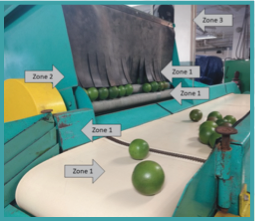
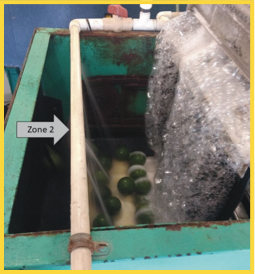
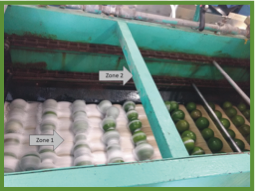
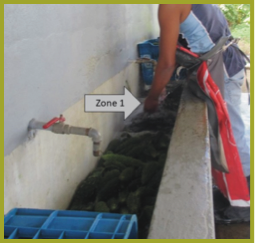
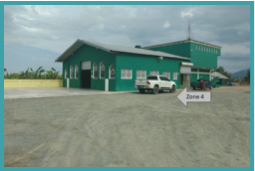
References:
1 United Fresh Produce Association. (2013). Guidance on Environmental Monitoring and Control of Listeria for the Fresh Produce Industry. Retrieved from https://www.centerforproducesafety.org/amass/documents/document/263/Listeria%20Guidance%20UFPA%202013.pdf
2 U.S. Food and Drug Administration. (2017). Draft guidance for industry: control of Listeria monocytogenes in ready-to-eat foods. Retrieved from https://www.fda.gov/regulatory-information/search-fda-guidance-documents/draft-guidance-industry-control-listeria-monocytogenes-ready-eat-foods
3 Zink, D. L. Swabbing Zones, Understanding Zones and Interpretation of Data. In Center for Food Safety and Applied Nutrition, U.S. Food and Drug Administration, College Park, MD. Retrieved from http://www.afdo.org/Resources/Documents/4-news-and-events/past-presentations/1006190900Zink.pdf
Status and Revision History
Published on Dec 16, 2019
Published with Full Review on May 08, 2023


























































